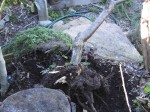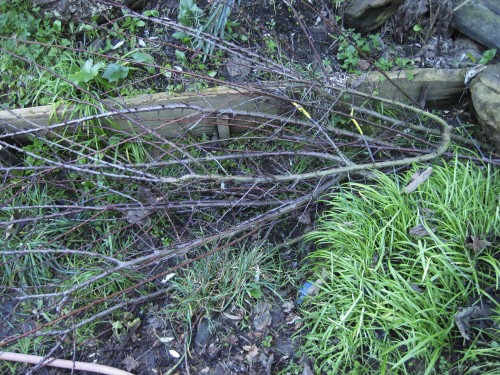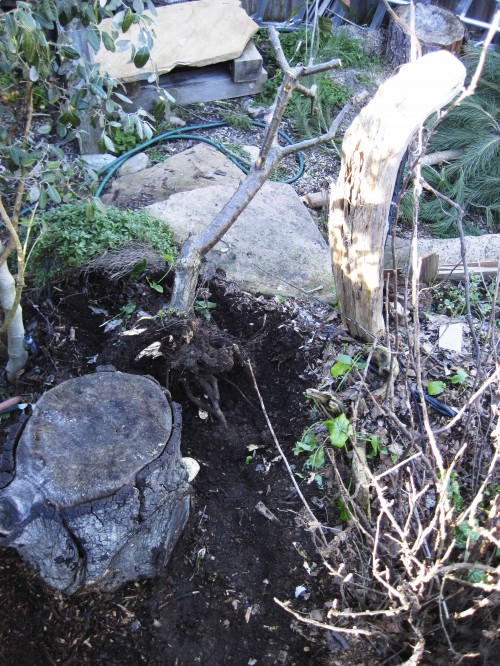
Time to remove the apricot tree, Grandpa’s Apricot Tree, in our back garden. Almost no fruit in at least 6 years. Seasons, soil, water, and our hungry food-producing mindsets will wait no longer! Time to nurture another tree. We will plant a Santa Rosa plum tree, who’s namesake is the next town over from our sunny California garden.
Almost! I almost got the entire apricot rootball out before coming to my senses. Yes, I like to create an animal habitat EVERY time I dig into the soil. But, I thought I would shortcut that vision because so many parts of the garden call for my attention. (Truth be told, the garden would do very well without my meddling.) Then, with ¾’s of the root ball removed and even less breath in my lungs, I came to my senses.
Yes!, this is a habitat. I can stop right here. This rootwad DOES NOT have to be completely removed from the bed. The Santa Rosa plum can be planted next to the almost-removed rootball of Grandpa’s Apricot Tree. My exhausted muscles can think of many reasons why to keep the leaned over, buried tree trunk. Watch today’s video and the next 2 to come to find out why!
Habitat it and they will come!
20130130 Grandpa’s Apricot Root Worlds Fair 1 of 3
(video):
20130130 Grandpa’s Apricot Root Worlds Fair (pics):
 The apricot tree was pruned to make removal easier. Note the old grafting sites (with yellow grafting sealer); even new stock would not produce fruit. A shame – the tree growth was vigorous with beautiful structure and wood/bark.
The apricot tree was pruned to make removal easier. Note the old grafting sites (with yellow grafting sealer); even new stock would not produce fruit. A shame – the tree growth was vigorous with beautiful structure and wood/bark.
 A tree is down! Repeat, a tree is down! After cutting some roots with a shovel, and bronco-riding the tree, other roots snapped and the tree was rendered a soil dweller.
A tree is down! Repeat, a tree is down! After cutting some roots with a shovel, and bronco-riding the tree, other roots snapped and the tree was rendered a soil dweller.
 Close-up of nearly removed apricot tree and its rootball. This is where, when I discovered that the tree need not be completely removed, that the soil-rich rootball makes a fantastic garden animal habitat.
Close-up of nearly removed apricot tree and its rootball. This is where, when I discovered that the tree need not be completely removed, that the soil-rich rootball makes a fantastic garden animal habitat.
Enjoy your habitat thinking-out-of-the-box creations. Nothin‘ is “debris“ in a habitat garden food forest!
Tony
